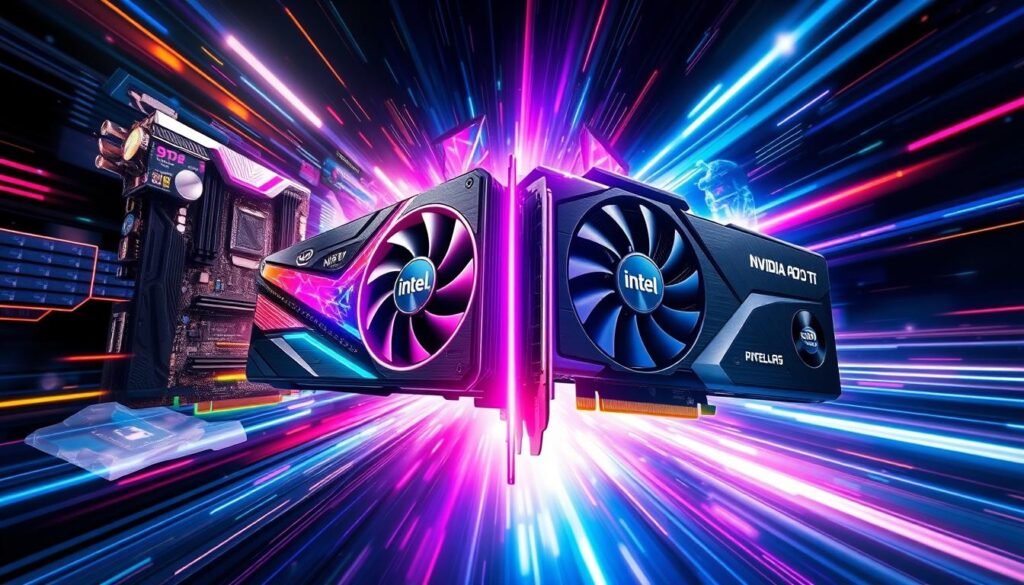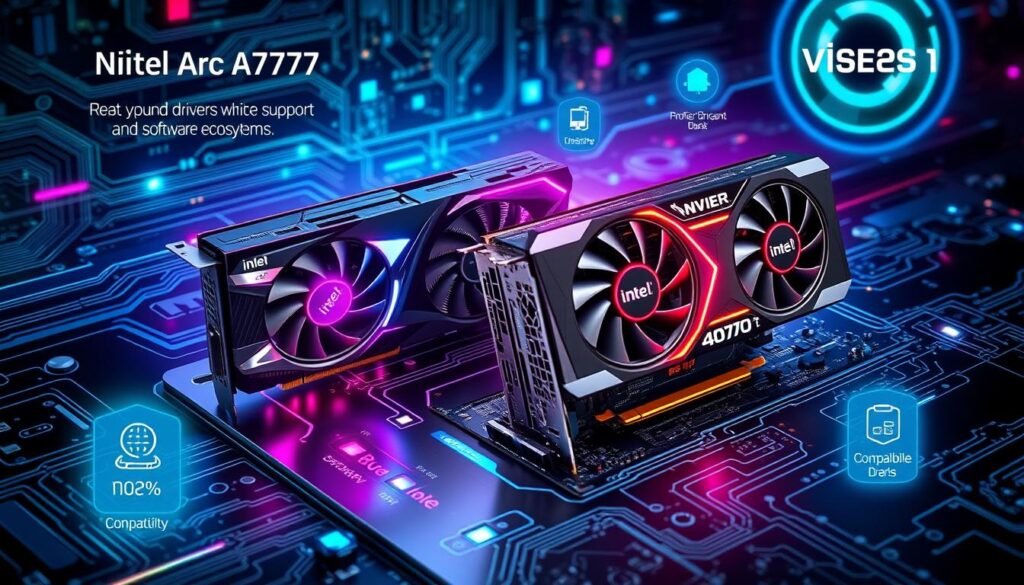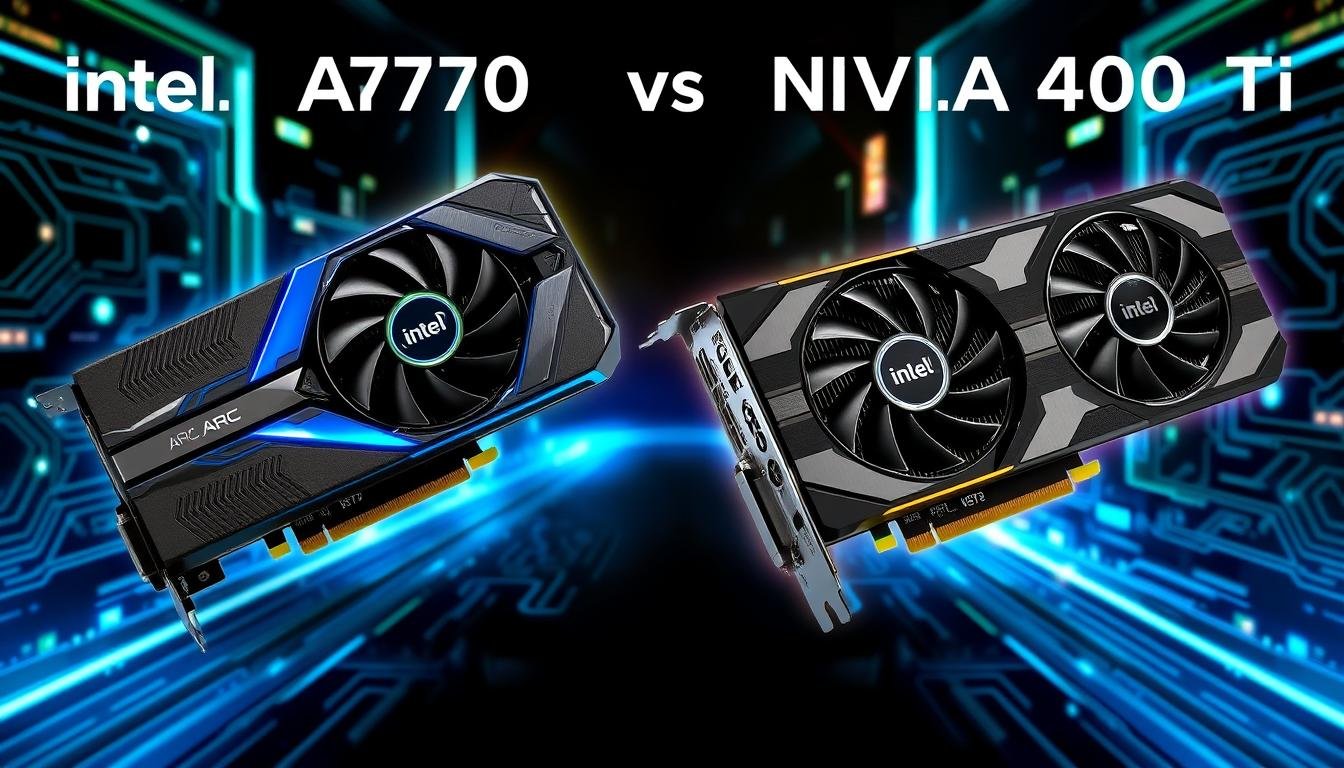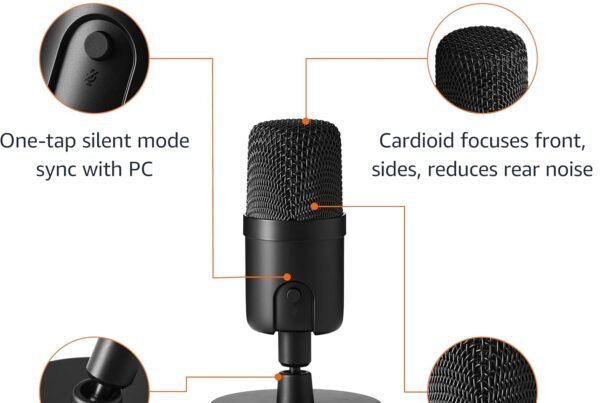The battle between Intel’s Arc A770 and NVIDIA’s RTX 4070 Ti is heating up. Tech fans and gamers are eager to know who will win. We’ll look closely at their design, performance, and value to find out.
So, how does the Intel Arc A770 compare to the RTX 4070 Ti? We’ll explore their performance, power use, and future-ready features. Join us to see which graphics card is best for gaming and creating content.
Contents
- 1 Overview of GPU Architecture and Specifications
- 2 Price Point and Market Positioning
- 3 Raw Performance Benchmarks
- 4 Memory Configuration and Bandwidth Analysis
- 5 Power Consumption and Efficiency
- 6 Intel Arc A770 vs 4070 Ti: Gaming Performance
- 7 Ray Tracing and AI Features
- 8 Driver Support and Software Ecosystem
- 9 Display Output and Connectivity Options
- 10 Cooling Solutions and Physical Design
- 11 Conclusion
- 12 FAQ
- 12.1 What are the key specifications of the Intel Arc A770 and NVIDIA RTX 4070 Ti GPUs?
- 12.2 How do the architectural differences between the Intel Arc A770 and NVIDIA RTX 4070 Ti impact their performance?
- 12.3 How do the price points and market positioning of the Intel Arc A770 and NVIDIA RTX 4070 Ti differ?
- 12.4 How do the Intel Arc A770 and NVIDIA RTX 4070 Ti perform in real-world gaming benchmarks?
- 12.5 How do the Intel Arc A770 and NVIDIA RTX 4070 Ti compare in terms of memory configuration and bandwidth?
- 12.6 How do the power consumption and efficiency of the Intel Arc A770 and NVIDIA RTX 4070 Ti compare?
- 12.7 How do the ray tracing and AI-enhanced graphics features of the Intel Arc A770 and NVIDIA RTX 4070 Ti compare?
- 12.8 How do the driver support and software ecosystem compare between the Intel Arc A770 and NVIDIA RTX 4070 Ti?
- 12.9 What are the display output and connectivity options for the Intel Arc A770 and NVIDIA RTX 4070 Ti?
Key Takeaways
- The Intel Arc A770 offers a compelling price-to-performance ratio, challenging the premium-priced RTX 4070 Ti.
- Architectural differences between Intel’s Alchemist and NVIDIA’s Ada Lovelace technology lead to distinct performance characteristics.
- Power efficiency and thermal management play a crucial role in determining the optimal choice for your system.
- Advanced features like ray tracing and AI-powered upscaling could sway the decision for those seeking the latest graphics innovations.
- The Intel Arc A770’s growing market share and user popularity suggest it’s a strong contender in the high-end GPU landscape.
Overview of GPU Architecture and Specifications
The Intel Arc Alchemist and NVIDIA RTX 4070 Ti are at the forefront of GPU technology. They show the quick progress in GPU design. Each has its own way of handling tasks, highlighting the latest in GPU tech.
Intel Arc Alchemist Architecture
The Intel Arc Alchemist GPU, known as DG2-512, uses a 6nm process. It has 21.7 billion transistors. It has 4,096 shaders, 256 TMUs, and 128 ROPs, making it strong for gaming and creating content.
NVIDIA Ada Lovelace Technology
The NVIDIA RTX 4070 Ti is based on Ada Lovelace architecture. It uses a 4nm process and has 35.8 billion transistors. It has 7,680 CUDA cores, 240 TMUs, and 80 ROPs, showing NVIDIA’s lead in high-performance GPUs.
Core Technical Specifications
- Intel Arc Alchemist: 4,096 shaders, 256 TMUs, 128 ROPs
- NVIDIA RTX 4070 Ti: 7,680 CUDA cores, 240 TMUs, 80 ROPs
Both the Intel Arc Alchemist and NVIDIA RTX 4070 Ti support the latest graphics tech. They support DirectX 12 Ultimate, ray tracing, and AI acceleration. This ensures a top-notch gaming and content creation experience.
“The battle between the Intel Arc Alchemist and NVIDIA RTX 4070 Ti is a testament to the rapid evolution of GPU technology, with each offering unique architectural advantages and capabilities.”
Price Point and Market Positioning
The Intel Arc A770 16GB model costs $329, making it a mid-range graphics card. It targets the mainstream market. On the other hand, the NVIDIA RTX 4070 Ti starts at $799, placing it in the high-end segment.
Looking at price-to-performance ratio and value for money, the Intel Arc A770 shines. It has a cost-effectiveness score of 55.32, while the RTX 4070 Ti scores 48.90. This shows the A770 is more affordable for its performance.
The big price gap between the two GPUs impacts their market appeal. The Arc A770 is for those who want good performance without spending too much. The RTX 4070 Ti is for those who need top-notch graphics and are ready to pay more.
“The Intel Arc A770 offers exceptional value for money compared to the RTX 4070 Ti, making it a compelling choice for those seeking a balance of performance and affordability.”
Raw Performance Benchmarks
The Intel Arc A770 and the NVIDIA GeForce RTX 4070 Ti face off in a thrilling battle. In synthetic benchmarks, the RTX 4070 Ti takes the lead, leaving the Arc A770 in its dust. The Arc A770 scores a 3DMark Fire Strike Graphics score of 32,666, but the RTX 4070 Ti is expected to score much higher. This solidifies the RTX 4070 Ti as the more powerful graphics card.
Real-world Gaming Performance
In real-world gaming, the RTX 4070 Ti shows a clear edge. It delivers frame rates up to 100% faster than the Arc A770 at 1080p. At higher resolutions, the gap grows even wider. The RTX 4070 Ti beats the Arc A770 by 134% at 1440p and 4K.
Content Creation Capabilities
The RTX 4070 Ti shines in content creation tasks. Its higher CUDA core count and Tensor cores give it a big advantage. This means faster video editing, 3D rendering, and AI workflows. It leads to quicker rendering times and more efficient media processing.
| Metric | Intel Arc A770 | NVIDIA GeForce RTX 4070 Ti |
|---|---|---|
| 3DMark Fire Strike Graphics Score | 32,666 | Higher |
| 1080p Gaming Performance | 100% slower | 100% faster |
| 1440p Gaming Performance | 134% slower | 134% faster |
| 4K Gaming Performance | 134% slower | 134% faster |
| Content Creation Performance | Lower | Higher |
The data clearly shows the performance gap between the Intel Arc A770 and the NVIDIA GeForce RTX 4070 Ti. While the Arc A770 does well in synthetic benchmarks, the RTX 4070 Ti excels in real-world gaming and content creation. This highlights the RTX 4070 Ti’s superior abilities in these areas.
Memory Configuration and Bandwidth Analysis
The Intel Arc A770 and NVIDIA RTX 4070 Ti GPUs have different memory setups. The Arc A770 has 16 GB of GDDR6 memory, a 256-bit bus, and a 2000 MHz clock. This gives it a memory bandwidth of 560 GB/s. On the other hand, the RTX 4070 Ti has 12 GB of GDDR6X memory, a 192-bit bus, and a 1313 MHz clock. It has a memory bandwidth of 504.2 GB/s.
The Arc A770’s larger VRAM and slightly more memory bandwidth are great for tasks like high-resolution texture processing and video editing capabilities. But, the RTX 4070 Ti’s GDDR6X memory is more efficient. This could mean better power efficiency and lower heat.
| Specification | Intel Arc A770 | NVIDIA RTX 4070 Ti |
|---|---|---|
| Memory Type | GDDR6 | GDDR6X |
| Memory Capacity | 16 GB | 12 GB |
| Memory Bus Width | 256-bit | 192-bit |
| Memory Clock | 2000 MHz | 1313 MHz |
| Memory Bandwidth | 560 GB/s | 504.2 GB/s |
The Arc A770 has more VRAM and a bit more memory bandwidth. This makes it good for tasks that need high-quality video editing and handling big, high-resolution textures. But, the RTX 4070 Ti’s GDDR6X memory might be more efficient in some cases.
Power Consumption and Efficiency
The Intel Arc A770 and NVIDIA RTX 4070 Ti GPUs have big differences in power use. The Arc A770 uses 225W, while the RTX 4070 Ti uses 285W. This means the Arc A770 is more energy-efficient, with a score of 10.34 to the RTX 4070 Ti’s 19.86.
TDP Comparison
The Arc A770’s lower TDP comes from its efficient Alchemist architecture. It’s made on a 6nm process. The RTX 4070 Ti, on the other hand, uses more power with its Ada Lovelace architecture on a 5nm process. This makes the Arc A770 more power-efficient.
Power Draw Under Load
The actual power use can change, especially when overclocked. Cooling solutions and system setups also affect power draw. Testing and benchmarking are key to see how much power the Arc A770 and RTX 4070 Ti use in different situations.
Thermal Performance
Thermal performance is important for power efficiency and stability. The cooling systems, like heatsinks and fans, greatly impact how well these GPUs handle heat. Detailed thermal testing is needed to fully understand their thermal characteristics.
| Specification | Intel Arc A770 | NVIDIA RTX 4070 Ti |
|---|---|---|
| TDP | 225W | 285W |
| Power Efficiency Score | 10.34 | 19.86 |
“The Arc A770’s lower power requirements and better power efficiency suggest it may be a more energy-conscious choice for users concerned about their system’s power consumption and thermal performance.”
Intel Arc A770 vs 4070 Ti: Gaming Performance
The NVIDIA GeForce RTX 4070 Ti beats the Intel Arc A770 in gaming. It offers higher frame rates at all resolutions. This means a smoother and more fun gaming experience.
At 1080p, the RTX 4070 Ti averages 232 FPS. The Arc A770 only manages 116 FPS. The difference grows at 1440p, with the 4070 Ti reaching 152 FPS and the Arc A770 at 65 FPS.
Even at 4K, the 4070 Ti shines with 96 FPS. The Arc A770 trails behind at just 41 FPS.
| Resolution | Intel Arc A770 | NVIDIA GeForce RTX 4070 Ti |
|---|---|---|
| 1080p | 116 FPS | 232 FPS |
| 1440p | 65 FPS | 152 FPS |
| 4K | 41 FPS | 96 FPS |
The NVIDIA GeForce RTX 4070 Ti is the better choice for gamers. It leads in gaming performance benchmark and fps comparison in 4K gaming.

Ray Tracing and AI Features
The Intel Arc A770 and the NVIDIA GeForce RTX 4070 Ti both have ray tracing. This feature makes lighting in games and videos look real. The Arc A770 has 32 ray tracing units, and the RTX 4070 Ti has 60 RT cores.
These GPUs use AI in different ways. The RTX 4070 Ti has NVIDIA’s DLSS 3, with a new Frame Generation feature. The Arc A770 uses Intel’s XeSS. While both improve graphics and performance, DLSS usually does a better job.
| Feature | Intel Arc A770 | NVIDIA GeForce RTX 4070 Ti |
|---|---|---|
| Ray Tracing Units | 32 | 60 RT Cores |
| AI-Enhanced Graphics | XeSS | DLSS 3 with Frame Generation |
| AI Performance | Moderate | Excellent |
In summary, both GPUs have great ray tracing. But the RTX 4070 Ti’s DLSS 3 technology gives it an edge in AI graphics.
Driver Support and Software Ecosystem
NVIDIA leads in driver support and software ecosystem compared to Intel’s Arc lineup. NVIDIA’s GeForce drivers are known for their stability and frequent updates. They work well with the latest games and apps.
Intel’s Arc drivers, however, have had issues with some games since their launch. Intel is working to fix these problems. But, their driver support is not as strong as NVIDIA’s.
The RTX 4070 Ti comes with NVIDIA’s powerful software suite. This includes GeForce Experience, Broadcast, and NVIDIA Studio drivers. These tools help with game capture, livestreaming, and improving performance.
The RTX 4070 Ti also has great game compatibility. NVIDIA’s driver team works hard to ensure it runs smoothly. This strong software ecosystem and driver support are key for a smooth gaming or content creation experience.
| GPU | Driver Support | Software Ecosystem | Game Compatibility |
|---|---|---|---|
| Intel Arc A770 | Improving, but still faces some compatibility issues | Developing, but lacks the maturity of NVIDIA’s offerings | Improving, but not as extensive as NVIDIA’s game support |
| NVIDIA RTX 4070 Ti | Robust, stable, and frequently updated | Highly developed, with tools like GeForce Experience, Broadcast, and NVIDIA Studio | Vast and well-supported by a wide range of games |

Display Output and Connectivity Options
Intel Arc A770 and NVIDIA RTX 4070 Ti both have great connectivity options. The Arc A770 has 1x HDMI 2.1 and 3x DisplayPort 2.0. The RTX 4070 Ti has 1x HDMI 2.1 and 3x DisplayPort 1.4a.
Both GPUs are great for multi-monitor setups. This is perfect for work, creating content, and gaming. The Arc A770’s DisplayPort 2.0 might support newer display tech and higher resolutions better.
Port Configuration
- Intel Arc A770: 1x HDMI 2.1, 3x DisplayPort 2.0
- NVIDIA RTX 4070 Ti: 1x HDMI 2.1, 3x DisplayPort 1.4a
Multi-monitor Support
Both the Intel Arc A770 and NVIDIA RTX 4070 Ti support multi-monitor configurations. This lets users use many displays at once. It’s great for work and gaming.
The Arc A770’s DisplayPort 2.0 might handle display outputs better than the RTX 4070 Ti’s DisplayPort 1.4a. It could support newer display tech and higher resolutions like 4K@120Hz and 8K@60Hz via HDMI 2.1.
Cooling Solutions and Physical Design
The Intel Arc A770 and NVIDIA GeForce RTX 4070 Ti have unique cooling and design features. The Arc A770 uses a dual-slot cooling system. The RTX 4070 Ti has a dual-slot design with a flow-through cooling method.
Stock cooling solutions are a starting point for both GPUs. But, third-party designs can improve cooling and look. These include dual-fan and triple-fan setups, fitting different cooling needs and system sizes.
The RTX 4070 Ti needs stronger cooling due to its higher TDP. On the other hand, the Arc A770 is more power-efficient. This might allow for smaller cooling solutions in some cases.
The physical size of these GPUs can differ based on the maker and model. Yet, both the Arc A770 and RTX 4070 Ti fit in a dual-slot space. This makes them compatible with many computer cases and motherboards.
Cooling Solutions Comparison
| Feature | Intel Arc A770 | NVIDIA GeForce RTX 4070 Ti |
|---|---|---|
| Cooling Design | Dual-slot cooling solution | Dual-slot design with flow-through cooling |
| Third-Party Cooling Options | Dual-fan and triple-fan designs available | Dual-fan and triple-fan designs available |
| Thermal Performance | Power-efficient design, may require less robust cooling | Higher TDP, generally requires more robust cooling |
| Dimensions | Varies by manufacturer and model | Varies by manufacturer and model |
The cooling and design of the Intel Arc A770 and NVIDIA GeForce RTX 4070 Ti are key. They help in efficient heat dissipation and keeping performance high. Both GPUs offer various cooling options, meeting the needs of PC fans and builders.
Conclusion
The comparison between the Intel Arc A770 and the NVIDIA RTX 4070 Ti shows the RTX 4070 Ti leads in most areas. It excels in gaming, ray tracing, and content creation. This makes it the top pick for those wanting the best graphics in their gaming PCs.
The Intel Arc A770, however, is a more affordable choice. It offers strong 1080p and 1440p gaming. It’s great for those watching their budget or focusing on energy efficiency.
In the end, picking between the RTX 4070 Ti and the Arc A770 depends on what you need. The RTX 4070 Ti is best for top-notch gaming and content creation. The Arc A770 is a smart choice for those looking for a good deal without sacrificing too much performance.









